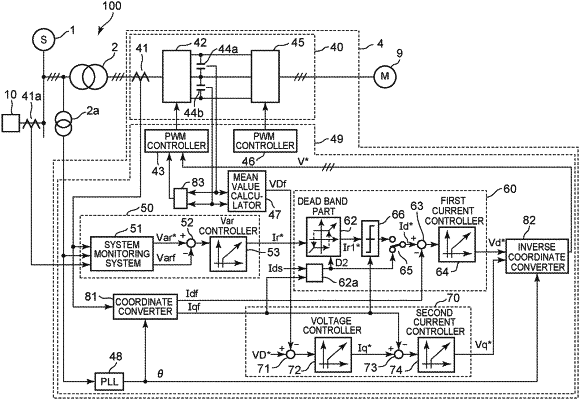| CPC H02M 5/4585 (2013.01) [H02M 7/483 (2013.01); H02M 7/487 (2013.01); H02M 7/4833 (2021.05); H02P 27/08 (2013.01); H02P 27/14 (2013.01); H02P 2201/01 (2013.01)] | 9 Claims |

|
1. A power conversion apparatus that drives a motor by receiving a three-phase AC voltage from an AC power system, comprising:
a multi-level converter that converts three-phase AC power to DC power;
an inverter connected to a DC output of the multi-level converter and receives the DC power outputted from the multi-level converter to output three-phase AC power for driving the motor;
a plurality of capacitors connected to the DC output of the multi-level converter; and
a control unit for controlling the multi-level converter and the inverter, wherein the control unit comprises:
a current detector that detects a three-phase alternating current supplied from the AC power system to the multi-level converter;
a coordinate converter that receives a current value outputted from the current detector and outputs an active current feedback value equivalent to an active current and a reactive current feedback value equivalent to a reactive current;
a reactive current setting unit that generates and outputs a first reactive current reference based on the active current feedback value;
a dead band setting unit that sets a dead band based on the first reactive current reference with respect to a second reactive current reference and outputs a third reactive current reference;
a first current controller that controls the reactive current feedback value to follow the third reactive current reference and generates a first voltage command;
a voltage controller that generates an effective current reference so that a voltage of the plurality of capacitors follows a DC voltage reference;
a second current controller that controls the active current feedback value to follow the effective current reference and generates a second voltage command; and
an inverse coordinate converter that generates a three-phase AC voltage command from an output value of the first current controller and an output value of the second current controller.
|